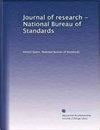Precipitation of NH4UO2PO4·3H2O—Solubility and Structural Comparison with Alkali Uranyl(2 +) Phosphates
Journal of research of the National Bureau of Standards
Pub Date : 1988-07-01
DOI:10.6028/jres.093.148
引用次数: 16
Abstract
Precipitates formed in the system UO2(NO3)2-NH4OH-H3PO4-H2O, aged for 30 days at 298 K, were studied. The precipitates were characterized by chemical and thermogravimetric analyses, x-ray powder diffraction, infrared spectroscopy, polarized light microscopy, and by their fluorescent properties. The precipitation boundary was established tindallometrically and microscopically. On the basis of these measurements, the stability conditions, structural parameters, and solubility of the tetragonal polymorph of NH4[UO2PO4]·3H2O were determined. This compound shows a close structural relationship with H3O[UO2PO4]·3H2O (space group P4/ncc) and alkali uranyl(2+)phosphates polyhydrates M[UO2PO4]·nH2O (n =4 for M=Li; n =3 for M=Na, K, Rb and n =2.5 for M=Cs). The unit-cell dimensions determined for NH4UO2PO4·3H2O are: a=b=7.02 Å, c=18.08 Å (P4/ncc). The thermodynamic solubility product constant, Ks=a(NH4+)×a(UO22+)×a(PO43−), for NH4UO2PO4·3H2O was determined: log Ks= −26.50±0.09. The Ks values of M[UO2PO4]·n H2O (at ionic strength, I=0.23 mol dm−3) calculated from previously published experimental data by using correct stability constants of uranyl(2+)phosphate complexes are: log Ks=−22.61±0.08 for M=Na; log Ks= −23.92±0.12 for M=K; log Ks= −24.13±0.19 for M=Rb; log Ks= −23.80±0.20 for M=Cs; and log Ks= −24.74±0.10 for M=NH4,showing that NH4UO2PO4·3H2O is less soluble than corresponding alkali uranyl(2+)phosphates.NH4UO2PO4·3h2o的沉淀——与碱性磷酸铀酰(2 +)的溶解度及结构比较
研究了UO2(NO3)2-NH4OH-H3PO4-H2O体系在298 K时效30 d后形成的析出物。通过化学和热重分析、x射线粉末衍射、红外光谱、偏振光显微镜及其荧光特性对析出物进行了表征。通过测量和显微方法建立了沉淀边界。在此基础上,确定了NH4[UO2PO4]·3H2O的稳定性条件、结构参数和溶解度。该化合物与h30o [UO2PO4]·3H2O(空间群P4/ncc)和碱性磷酸铀酰(2+)多水系M[UO2PO4]·nH2O (n =4, M=Li;M=Na, K, Rb时n =3, M=Cs时n =2.5)。NH4UO2PO4·3H2O的单元胞尺寸为:a=b=7.02 Å, c=18.08 Å (P4/ncc)。测定了NH4UO2PO4·3H2O的热力学溶解度积常数Ks=a(NH4+)×a(UO22+)×a(PO43−):log Ks=−26.50±0.09。利用铀酰(2+)磷酸配合物的正确稳定性常数,根据已发表的实验数据计算出M[UO2PO4]·n H2O(离子强度I=0.23 mol dm−3)的Ks值为:M=Na时,log Ks=−22.61±0.08;M=K时,log K =−23.92±0.12;对于M=Rb, log Ks=−24.13±0.19;M=Cs时,log k =−23.80±0.20;M=NH4时,log Ks=−24.74±0.10,表明NH4UO2PO4·3H2O的可溶性低于相应的碱性磷酸铀酰(2+)。
本文章由计算机程序翻译,如有差异,请以英文原文为准。
求助全文
约1分钟内获得全文
求助全文

 求助内容:
求助内容: 应助结果提醒方式:
应助结果提醒方式:


